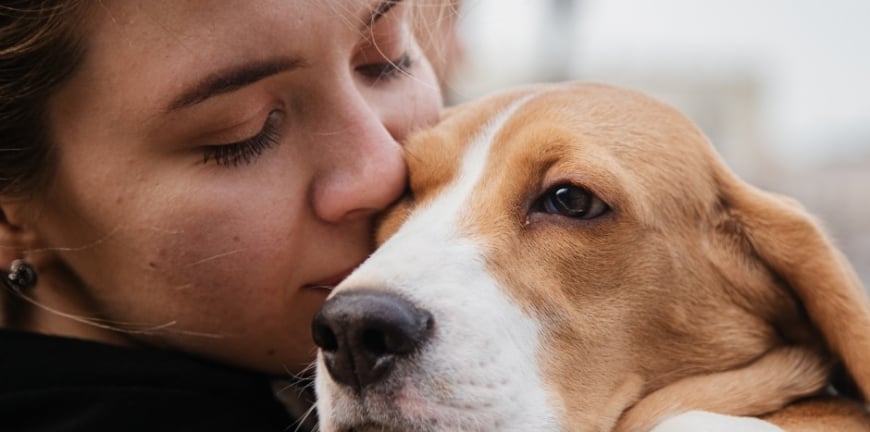May 18, 2025

How Our Emotions Shape Our Pets’ Lives
How Our Emotions Shape Our Pets’ Lives—The Mood Mirror.
There’s an old Japanese saying: Kokoro no heiwa ga, shin no kōfuku e no michi – “Peace of mind is the path to true happiness.” This saying emphasises that genuine happiness stems from inner tranquillity. In the context of our relationships with pets, it suggests that maintaining a calm and peaceful heart not only benefits our well-being but also creates a harmonious environment for our animal companions, who live not only beside us but also within close proximity of our moods.
Known as emotional contagion, it’s described as “the basic form of empathy where dogs can catch feelings just as humans do. For instance, a dog might sense its owner’s distress and respond by becoming more subdued or showing signs of stress like pacing or whining [1]”.
I’ve seen it again and again with cats as well as dogs. Someone calls me about a friend’s Ragdoll that has stopped using the litter tray and is using the shower to toilet in instead. But it’s not the tray that’s changed—it’s the woman. She’s a new parent, having difficulties with her partner. Her mornings have turned from coffee and radio to clenched silence and too much time spent staring at screens. The cat, once curled at the foot of the bed, has retreated. Why? Not in rebellion. But in resonance.
The Invisible Leash of Emotion
Pets, like children, read us beyond words. They learn our rhythms: the sound of our footsteps when we’re calm versus hurried; the texture of our voice when we’re angry versus weary. They tune into the unsaid. They live in what the Japanese call ma — the space between things, the silence between words.
Dogs often mirror our energy in a more external way: bouncing when we’re excited, anxious when we’re tense. Cats, though often seen as aloof, are deeply sensitive creatures. Their behavioural shifts are often misread as “moods” when they are, in fact, adaptations to the currents we send out daily.
Emotional Contagion Isn’t Just Human
Research in recent years has confirmed what many of us intuitively know: animals can experience emotional contagion. They absorb and reflect our moods not only through body language but through hormonal and neurological responses. If we are stressed, they become more alert. If we are chronically anxious, they may become withdrawn, over-groomed, or exhibit what we call “problem behaviours”—which are often cries for emotional equilibrium.
Recent research supports the idea that animals can experience emotional contagion, absorbing and reflecting human emotions through behavioural and physiological responses.
For instance, a 2019 study published in Frontiers in Psychology examined the relationship between dog owners and their pets. The researchers found that dogs’ heart rate variability, an indicator of emotional state, correlated with their owners’ stress levels. This suggests that dogs can mirror their owners’ emotional states, a phenomenon influenced by the duration of their relationship and shared environment
Additionally, a 2024 study led by the University of Bristol revealed that dogs exposed to the scent of human stress exhibited more ‘pessimistic’ behaviour in cognitive tasks. This indicates that dogs can detect human stress through olfactory cues, leading to changes in their own emotional states.
These findings underscore the profound impact human emotions can have on our pets, highlighting the importance of maintaining a calm and positive environment for their well-being.
So, What Can We Do?
First, notice. Before jumping to conclusions about your pet’s behaviour, ask:
- What’s happening in my life right now?
- Have my routines shifted?
- Have I been moving through the house like a storm cloud or a steady breeze?
Second, ground yourself. You don’t have to be perfect. But even small acts of emotional hygiene—breathing deeply, speaking more softly, pausing to stroke your cat with presence—can ripple outward.
A Mutual Practice
Living with animals isn’t a one-way caretaking street. It’s a practice—like zazen or calligraphy—where presence shapes outcome. Our pets may not fully understand our words, but they know when we are truly there. And perhaps that’s the quiet invitation they extend to us every day. To come home to ourselves, so they can fully come home to us.
If your cat or dog is displaying sudden behavioural changes, take a moment to reflect—not just on their world, but yours. Need support decoding this silent language?
📩 Get in touch for a consultation.
 Author Bio: Carla Francis (Dip. CMA. Fel) is the internationally recognised author of three books translated into multiple languages and is also the in-house pet travel expert for PetsForever app. With a background in writing, education, and a Diploma in Feline Psychology & Behaviour, Carla has dedicated her career to improving the lives of pets.
Author Bio: Carla Francis (Dip. CMA. Fel) is the internationally recognised author of three books translated into multiple languages and is also the in-house pet travel expert for PetsForever app. With a background in writing, education, and a Diploma in Feline Psychology & Behaviour, Carla has dedicated her career to improving the lives of pets.
*Note: The information shared here is educational and not a substitute for professional veterinary advice. For specific concerns, please consult a qualified vet. Read our full Disclaimer.